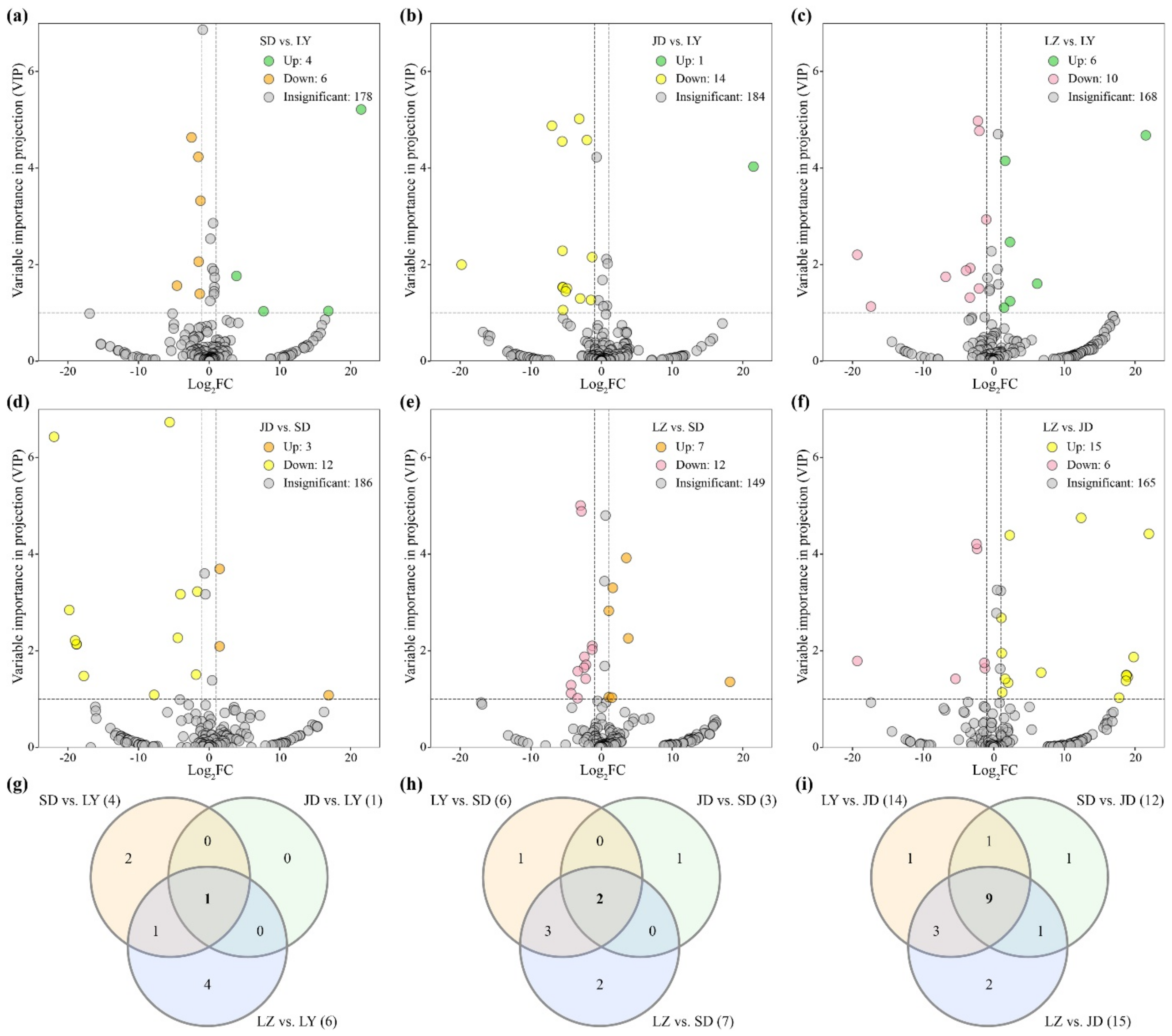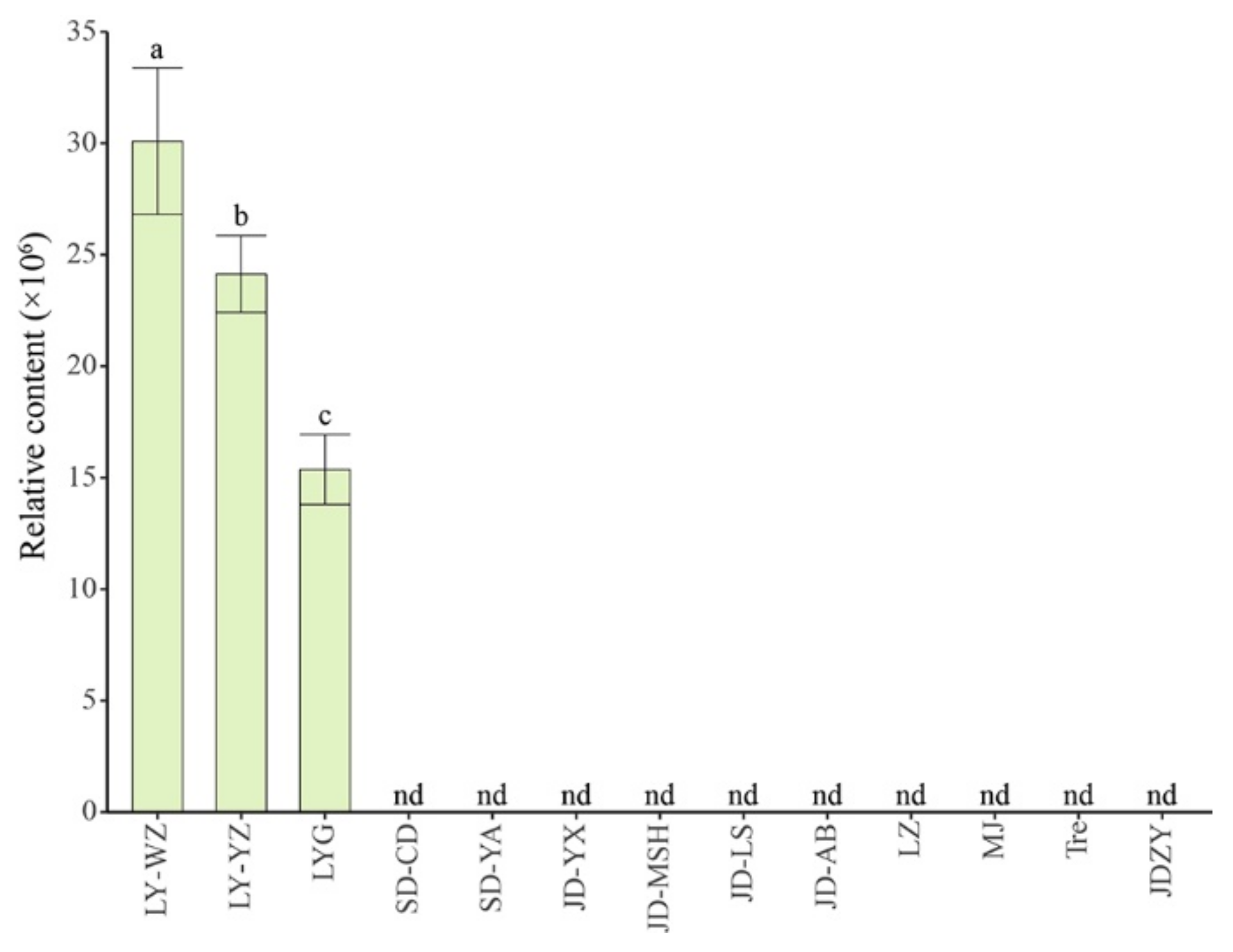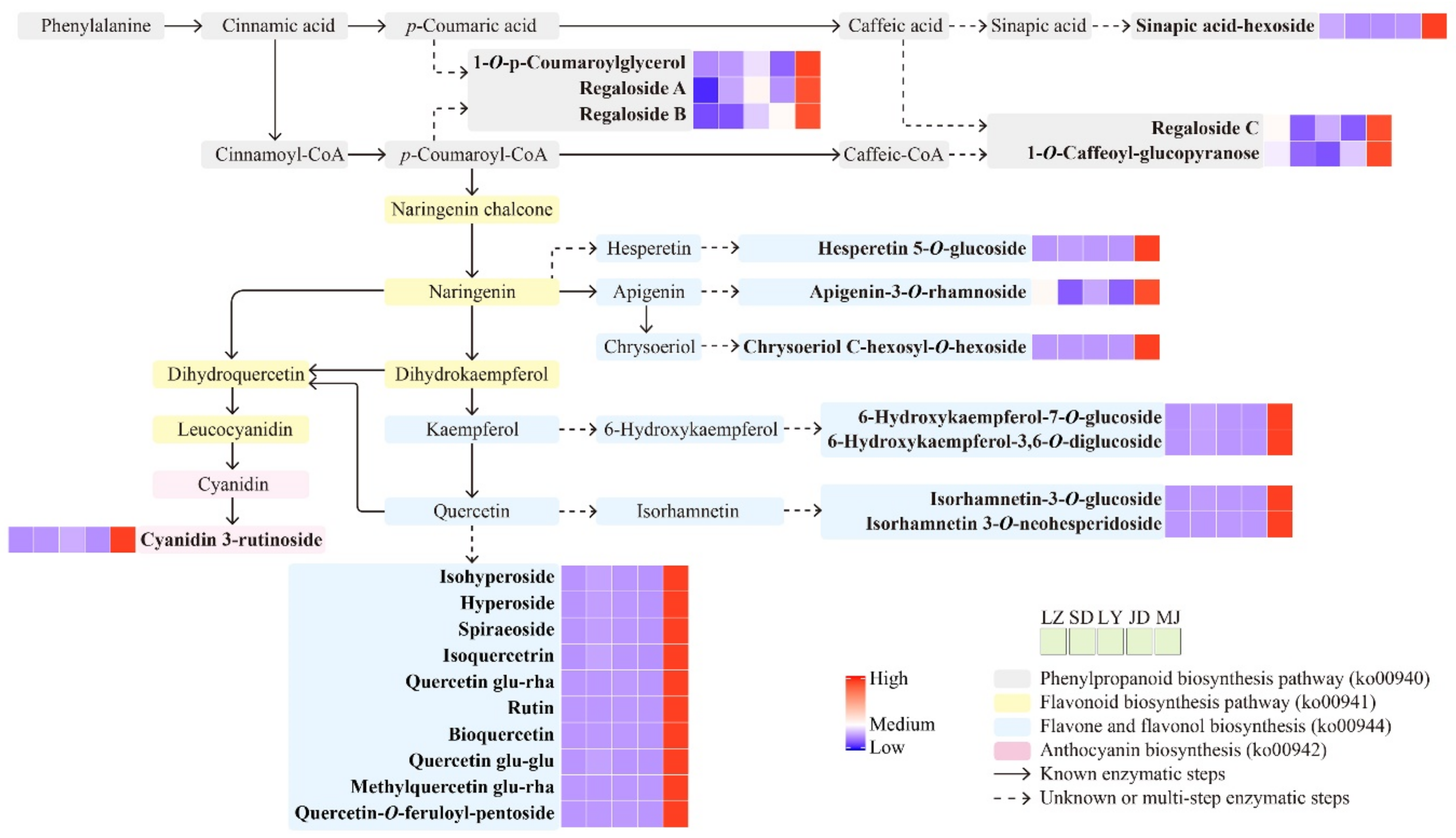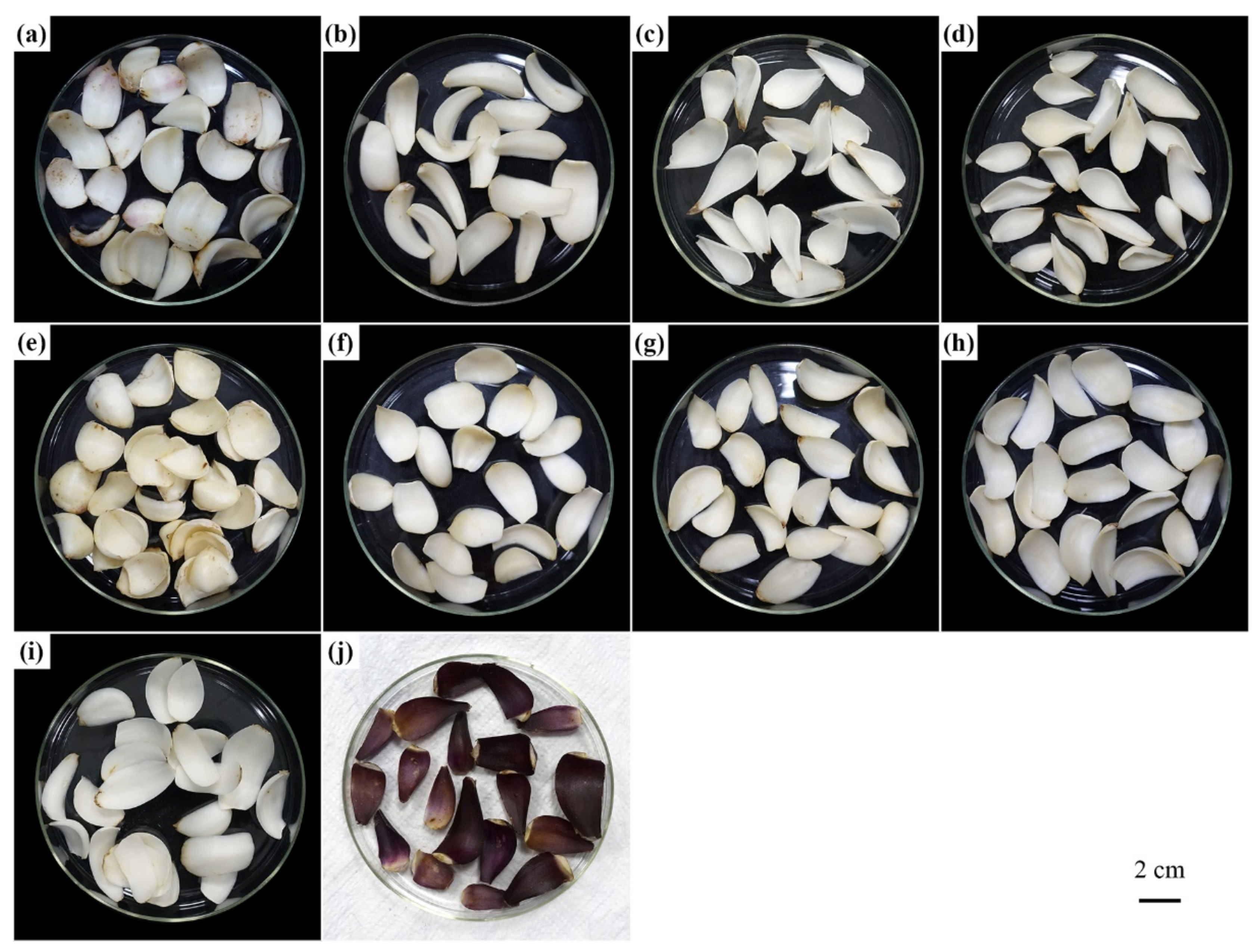Metabolome-Based Discrimination Analysis of Five Lilium Bulbs Associated with Differences in Secondary Metabolites
Abstract
1. Introduction
2. Results and Discussion
2.1. Metabolite Profiling Analysis of Five Lilium Bulbs
2.2. Differential Metabolite Analysis in Medical Lily Bulbs
2.2.1. Differential Metabolites in LY Bulbs
2.2.2. Differential Metabolites in SD Bulbs
2.2.3. Differential Metabolites in JD Bulbs
2.3. Differential Metabolites Analysis Sweet and Bitter Lily Bulbs
2.4. Differential Metabolite Analysis between Purple and White Lily Bulbs
3. Materials and Methods
3.1. Plant Material
3.2. Reagents
3.3. Sample Extraction
3.4. HPLC–MS/MS Analysis
3.5. Metabolite Annotation and Quantification
3.6. Screening of Differential Metabolites
4. Conclusions
Supplementary Materials
Author Contributions
Funding
Data Availability Statement
Conflicts of Interest
Sample Availability
References
- Liang, S.; Minoru, N.T. Lilium. In Flora of China. Volume 24: Flagellariaceae through Marantaceae; Wu, Z., Raven, P.H., Hong, D., Eds.; Scidence Press & Missouri Botanical Garden Press: Beijing, China; St. Louis, MO, USA, 2000; pp. 135–149. [Google Scholar]
- Kong, Y.; Bai, J.; Lang, L.; Bao, F.; Dou, X.; Wang, H.; Shang, H. Floral scents produced by Lilium and Cardiocrinum species native to China. Biochem. Syst. Ecol. 2017, 70, 222–229. [Google Scholar] [CrossRef]
- McRae, E.A. Lilies: A Guide for Growers and Collectors; Timber Press: Portland, OR, USA, 1998; p. 19. [Google Scholar]
- Kong, Y.; Wang, H.; Lang, L.; Dou, X.; Bai, J. Analysis on the contents of 13 intrinsic free sugars in different lily samples. Food Sci. in press (In Chinese).
- Erb, M.; Kliebenstein, D.J. Plant secondary metabolites as defenses, regulators, and primary metabolites: The blurred functional trichotomy. Plant Physiol. 2020, 184, 39–52. [Google Scholar] [CrossRef] [PubMed]
- Haw, S.G. The history of lilies in China. In The Lilies of China; Haw, S.G., Ed.; Timber Press: London, UK, 1986; pp. 43–56. [Google Scholar]
- Chinese Pharmacopoeia Commission. Pharmacopoeia of The Peoples Republic Of China (Part I), 2020th ed.; China Pharmaceutical Science and Technology Press: Beijing, China, 2020; p. 137. [Google Scholar]
- Luo, J.; Li, L.; Kong, L. Preparative separation of phenylpropenoid glycerides from the bulbs of Lilium lancifolium by high-speed counter-current chromatography and evaluation of their antioxidant activities. Food Chem. 2012, 131, 1056–1062. [Google Scholar] [CrossRef]
- Ma, T.; Wang, Z.; Zhang, Y.M.; Luo, J.-G.; Kong, L.-Y. Bioassay-guided isolation of anti-inflammatory components from the bulbs of Lilium brownii var. viridulum and identifying the underlying mechanism through acting on the NF-κB/MAPKs pathway. Molecules 2017, 22, 506. [Google Scholar] [CrossRef]
- Jin, L.; Zhang, Y.; Yan, L.; Guo, Y.; Niu, L. Phenolic compounds and antioxidant activity of bulb extracts of six Lilium species native to China. Molecules 2012, 17, 9361–9378. [Google Scholar] [CrossRef]
- Zhu, M.; Luo, J.; Lv, H.; Kong, L. Determination of anti-hyperglycaemic activity in steroidal glycoside rich fraction of lily bulbs and characterization of the chemical profiles by LC-Q-TOF-MS/MS. J. Funct. Foods 2014, 6, 585–597. [Google Scholar] [CrossRef]
- Xu, Z.; Wang, H.; Wang, B.; Fu, L.; Yuan, M.; Liu, J.; Zhou, L.; Ding, C. Characterization and antioxidant activities of polysaccharides from the leaves of Lilium lancifolium Thunb. Int. J. Biol. Macromol. 2016, 92, 148–155. [Google Scholar] [CrossRef] [PubMed]
- Hu, Y.; Du, Y.; Zhang, M.; Zhang, X.; Ren, J. Characters and comprehensive evaluation of nutrients and active components of 12 Lilium species. Nat. Prod. Res. Dev. 2019, 31, 292–298. (In Chinese) [Google Scholar] [CrossRef]
- Wang, F.; Wang, W.; Niu, X.; Huang, Y.; Zhang, J. Isolation and structural characterization of a second polysaccharide from bulbs of Lanzhou lily. Appl. Biochem. Biotech. 2018, 186, 535–546. [Google Scholar] [CrossRef]
- Drewnowski, A.; Gomez-Carneros, C. Bitter taste, phytonutrients, and the consumer: A review. Am. J. Clin. Nutr. 2000, 72, 1424–1435. [Google Scholar] [CrossRef] [PubMed]
- Shimomura, H.; Sashida, Y.; Mimaki, Y. Bitter phenylpropanoid glycosides from Lilium speciosum var. rubrum. Phytochemistry 1986, 25, 2897–2899. [Google Scholar] [CrossRef]
- Shoyama, Y.; Hatano, K.; Nishioka, I.; Yamagishi, T. Phenolic glycosides from Lilium longiflorum. Phytochemistry 1987, 26, 2965–2968. [Google Scholar] [CrossRef]
- Shimomura, H.; Sashida, Y.; Mimaki, Y. Phenolic glycerides from Lilium auratum. Phytochemistry 1987, 26, 844–845. [Google Scholar] [CrossRef]
- Shimomura, H.; Sashida, Y.; Mimaki, Y.; Iida, N. Regaloside A and B, acylated glycerol glucosides from Lilium regale. Phytochemistry 1988, 27, 451–454. [Google Scholar] [CrossRef]
- Fox, D. Growing Lilies; Croom Helm Ltd.: Wolfeboro, NH, USA, 1985; p. 10. [Google Scholar]
- Liu, Y.; Lin-Wang, K.; Deng, C.; Warran, B.; Wang, L.; Yu, B.; Yang, H.; Wang, J.; Espley, R.V.; Zhang, J.; et al. Comparative transcriptome analysis of white and purple potato to identify genes involved in anthocyanin biosynthesis. PLoS ONE 2015, 10, e0129148. [Google Scholar] [CrossRef] [PubMed]
- Wang, C.; Shu, S.; Yin, F.; Zhao, J.; Zhang, Z.; Liu, X.; Zhan, Z. Textual research on origin and genuine of Lilii Bulbus. China J. Chin. Meter. Med. 2018, 43, 1732–1736. (In Chinese) [Google Scholar] [CrossRef]
- Zhang, W.; Wang, J.; Zhang, Z.; Peng, H.; Zhan, Z.; Yang, H. Herbal textual research on triditional Chinese medicine “Baihe” (Lilii Bulbus). China J. Chin. Mater. Med. 2019, 44, 5007–5011. (In Chinese) [Google Scholar] [CrossRef]
- Hong, X.-X.; Luo, J.-G.; Guo, C.; Kong, L.-Y. New steroidal saponins from the bulbs of Lilium brownii var. viridulum. Carbohydr. Res. 2012, 361, 19–26. [Google Scholar] [CrossRef] [PubMed]
- Hou, X.; Chen, F. Studies on chemical constituents of Lilium brownii. Acta Pharm. Sin. 1998, 33, 923–926. (In Chinese) [Google Scholar]
- Munafo, J.P.; Gianfagna, T.J., Jr. Chemistry and biological activity of steroidal glycosides from the Lilium genus. Nat. Prod. Rep. 2015, 32, 454–477. [Google Scholar] [CrossRef] [PubMed]
- Kharrat, N.; Aissa, I.; Dgachi, Y.; Aloui, F.; Chabchoub, F.; Bouaziz, M.; Gargouri, Y. Enzymatic synthesis of 1,3-dihydroxyphenylacetoyl-sn-glycerol: Optimization by response surface methodology and evaluation of its antioxidant and antibacterial activities. Bioorg. Chem. 2017, 75, 347–356. [Google Scholar] [CrossRef]
- Lim, T.K. Lilium lancifolium. In Edible Medicinal and Non Medicinal Plants (Volume 8, Flowers); Lim, T.K., Ed.; Springer: Dordrecht, The Netherlands, 2014; pp. 215–220. [Google Scholar] [CrossRef]
- Zhang, Y.-Y.; Luo, L.-M.; Wang, Y.-X.; Zhu, N.; Zhao, T.-J.; Qin, L. Total saponins from Lilium lancifolium: A promising alternative to inhibit the growth of gastric carcinoma cells. J. Cancer 2020, 11, 4261–4273. [Google Scholar] [CrossRef]
- Heng, L.; Vincken, J.-P.; van Koningsveld, G.; Legger, A.; Gruppen, H.; Van Boekel, T.; Roozen, J.; Voragen, F. Bitterness of saponins and their content in dry peas. J. Sci. Food Agric. 2006, 86, 225–1231. [Google Scholar] [CrossRef]
- Fiallos-Jurado, J.; Pollier, J.; Moses, T.; Arendt, P.; Barriga-Medina, N.; Morillo, E.; Arahana, V.; Torres, M.D.L.; Goossens, A.; Leon-Reyes, A. Saponin determination, expression analysis and functional characterization of saponin biosynthetic genes in Chenopodium quinoa leaves. Plant Sci. 2016, 250, 188–197. [Google Scholar] [CrossRef]
- Mennella, J.A.; Spector, A.C.; Reed, D.R.; Coldwell, S.E. The bad taste of medicines: Overview of basic research on bitter taste. Clin. Ther. 2013, 35, 1225–1246. [Google Scholar] [CrossRef] [PubMed]
- Kim, I.A.; Kim, B.-G.; Kim, M.; Ahn, J.-H. Characterization of hydroxycinnamoyltransferase from rice and its application for biological synthesis of hydroxycinnamoyl glycerols. Phytochemistry 2012, 76, 25–31. [Google Scholar] [CrossRef]
- Yamagishi, M.; Yoshida, Y.; Nakayama, M. The transcription factor LhMYB12 determines anthocyanin pigmentation in the tepals of Asiatic hybrid lilies (Lilium spp.) and regulates pigment quantity. Mol. Breed. 2012, 30, 913–925. [Google Scholar] [CrossRef]
- Khor, C.M.; Ng, W.K.; Kanaujia, P.; Chan, K.P.; Dong, Y. Hot-melt extrusion microencapsulation of quercetin for taste-masking. J. Microencapsul. 2017, 34, 29–37. [Google Scholar] [CrossRef]
- Chu, C.; Du, Y.; Yu, X.; Shi, J.; Yuan, X.; Liu, X.; Liu, Y.; Zhang, H.; Zhang, Z.; Yan, N. Dynamics of antioxidant activities, metabolites, phenolic acids, flavonoids, and phenolic biosynthetic genes in germinating Chinese wild rice (Zizania latifolia). Food Chem. 2020, 318, 126483. [Google Scholar] [CrossRef] [PubMed]
- Gan, R.-Y.; Chan, C.-L.; Yang, Q.-Q.; Li, H.-B.; Zhang, D.; Ge, Y.-Y.; Gunaratne, A.; Ge, J.; Corke, H. Bioactive compounds and beneficial functions of sprouted grains. In Sprouted Grains; Feng, H., Nemzer, B., DeVries, J.W., Eds.; AACC International Press: Duxford, UK, 2019; pp. 191–246. [Google Scholar] [CrossRef]
- Wang, D.; Zhang, L.; Huang, X.; Wang, X.; Yang, R.; Mao, J.; Wang, X.; Wang, X.; Zhang, Q.; Li, P. Identification of nutritional components in black sesame determined by widely targeted metabolomics and traditional Chinese medicines. Molecules 2018, 23, 1180. [Google Scholar] [CrossRef] [PubMed]
- Gu, Z.; Eils, R.; Schlesner, M. Complex heatmaps reveal patterns and correlations in multidimensional genomic data. Bioinformatics 2016, 32, 2847–2849. [Google Scholar] [CrossRef] [PubMed]
- Yan, N.; Du, Y.; Liu, X.; Chu, M.; Shi, J.; Zhang, H.; Liu, Y.; Zhang, Z. A comparative UHPLC-QqQ-MS-based metabolomics approach for evaluating Chinese and North American wild rice. Food Chem. 2019, 275, 618–627. [Google Scholar] [CrossRef] [PubMed]
- Heberle, H.; Meirelles, G.V.; da Silva, F.R.; Telles, G.P.; Minghim, R. InteractiVenn: A web-based tool for the analysis of sets through Venn diagrams. BMC Bioinform. 2015, 16, 169. [Google Scholar] [CrossRef]






| Name | Application a | Section b | Bulb Color | Province | Location | Code | Circumference (cm) c | Starch Content (%) |
|---|---|---|---|---|---|---|---|---|
| L. brownii var. viridulum | M&E | L | White | Jiangxi | Wanzai | LY-WZ | 19.80 ± 1.17 | 22.80 |
| Hunan | Yongzhou | LY-YZ | 23.13 ± 0.38 | / | ||||
| L. pumilum | M&E | S | White | Hebei | Chengde | SD-CD | 7.27 ± 0.13 | 14.55 |
| Shaanxi | Yan’an | SD-YA | 6.73 ± 0.33 | 12.06 | ||||
| L. lancifolium | M&E | S | White | Sichuan | A’ba | JD-AB | 13.80 ± 0.31 | 19.16 |
| Hunan | Longshan | JD-LS | 25.97 ± 0.15 d | 15.82 | ||||
| Anhui | Manshuihe | JD-MSH | 22.50 ± 0.26 d | 11.86 | ||||
| Jiangsu | Yixing | JD-YX | 27.03 ± 0.69 d | 17.99 | ||||
| L. davidii var. willmottiae | E | S | White | Gansu | Lanzhou | LZ | 15.97 ± 0.26 | 11.64 |
| L. regale | / | L | Purple | Beijing | Huairou | MJ | 14.40 ± 0.87 | 13.33 |
Publisher’s Note: MDPI stays neutral with regard to jurisdictional claims in published maps and institutional affiliations. |
© 2021 by the authors. Licensee MDPI, Basel, Switzerland. This article is an open access article distributed under the terms and conditions of the Creative Commons Attribution (CC BY) license (http://creativecommons.org/licenses/by/4.0/).
Share and Cite
Kong, Y.; Wang, H.; Lang, L.; Dou, X.; Bai, J. Metabolome-Based Discrimination Analysis of Five Lilium Bulbs Associated with Differences in Secondary Metabolites. Molecules 2021, 26, 1340. https://doi.org/10.3390/molecules26051340
Kong Y, Wang H, Lang L, Dou X, Bai J. Metabolome-Based Discrimination Analysis of Five Lilium Bulbs Associated with Differences in Secondary Metabolites. Molecules. 2021; 26(5):1340. https://doi.org/10.3390/molecules26051340
Chicago/Turabian StyleKong, Ying, Huan Wang, Lixin Lang, Xiaoying Dou, and Jinrong Bai. 2021. "Metabolome-Based Discrimination Analysis of Five Lilium Bulbs Associated with Differences in Secondary Metabolites" Molecules 26, no. 5: 1340. https://doi.org/10.3390/molecules26051340
APA StyleKong, Y., Wang, H., Lang, L., Dou, X., & Bai, J. (2021). Metabolome-Based Discrimination Analysis of Five Lilium Bulbs Associated with Differences in Secondary Metabolites. Molecules, 26(5), 1340. https://doi.org/10.3390/molecules26051340







